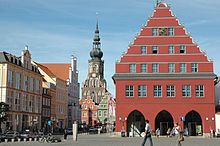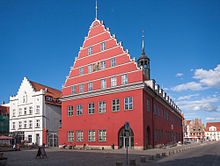Greifswald town hall
The town hall of Greifswald dates from the 13th century. It is largely preserved after several baroque changes. It is located in the center of Greifswald , directly on the market square (between the market and the fish market) of the city center in the immediate vicinity of the St. Nikolai Cathedral in the brick Gothic style .
timeline

In 1241 Greifswald received market rights. Mentioned for the first time as an oppidum in 1248, the city was granted the town charter in 1250 . The Greifswald town hall was built in the middle of the market, which has been preserved in its layout. The foundation walls of the town hall probably also date from around 1250. But it was not until 1349 that a Kophus was mentioned at this point. In 1551 the “Radhus” was first mentioned. Many changes have been made to the building since then. In 1713 the town hall burned down in the great city fire. It was restored until 1738 and then changed several times.
The elongated, plastered, red brick building has 16 window axes. The slightly curved, Baroque-style gable ends have had several strong cornices above the two basement floors since 1724 . Originally there were Gothic-arched, open halls with three Gothic gate openings on the gables, but these have since been closed - most recently in 1997.
The steep gable roof is closed above with an open baroque roof turret. From here the bell rings once every hour during the day. The side passage between the neighboring pharmacy has been closed to free passage for some time.
In the former council chamber and later wedding room, the baroque stucco ceiling by Balthasar Braun from 1748 and the now restored painted wallpaper with mythological depictions by the Holzerlanden brothers from 1749 are remarkable . The ribbed vault stands on 7-cornered central pillars. The basement rooms are now used for exhibitions and socializing.
The town hall has had a heavy bronze door since 1966, which was created by the sculptor Jo Jastram and contains a text fragment from Brecht's children 's hymn . The relief commemorates the surrender of Greifswald to the Red Army on April 29, 1945 without a fight .
From 1996 to 1997 the town hall was extensively renovated. It now got its strong medieval dark red color (ox blood red) and became the “Red Town Hall”.
The marketplace, which encompasses all sides, was renewed in 1998/99 according to plans by Hinnerk Wehberg (office WES) as a spacious, Hanseatic plain square with a new fishing fountain and corner steles.
literature
- Hartmut Brun , Theodor Müller: Town halls in Mecklenburg-Western Pomerania ; Hinstorff-Verlag, Rostock, 2001, ISBN 3-356-00912-5
- Georg Dehio: Handbook of German Art Monuments - Mecklenburg ; Deutscher Kunstverlag, Munich and Berlin, 1980
- City of Greifswald (Hrsg.): Tooth for a tooth - tear off or preserve? Greifswald, 2000
Web links
- Town hall at Greifswald.de
Coordinates: 54 ° 5 '44.7 " N , 13 ° 22' 49.8" E

